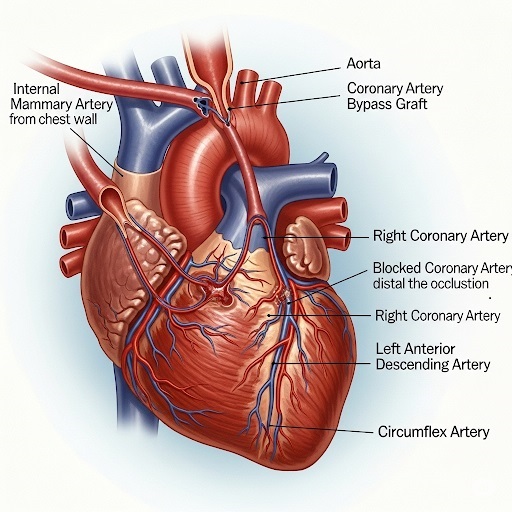Coronary Artery Bypass Graft (CABG): A Global Guide for Patients
What Is Coronary Artery Bypass Graft (CABG)?

Coronary Artery Bypass Graft (CABG) is a life-saving cardiac surgery that improves blood flow to the heart by bypassing blocked or narrowed coronary arteries. As one of the most common heart surgeries globally, CABG is often recommended for patients with advanced coronary artery disease (CAD) where medications and less invasive procedures are not enough.
Why Do Patients Need CABG?
When coronary arteries are clogged due to plaque buildup (atherosclerosis), the heart muscle receives less oxygen. This can lead to chest pain (angina), heart attacks, or sudden cardiac death. CABG reroutes blood around these blockages using a healthy vessel taken from the leg, arm, or chest.
Who Is a Candidate for CABG?
- Multiple blocked coronary arteries
- Diabetes with complex coronary disease
- Previous stent or angioplasty failure
- Ongoing chest pain despite optimal medication
Patients with other health issues such as pelvic organ prolapse may need special preoperative planning, particularly if traveling abroad for treatment.
Types of CABG Surgery
On-Pump CABG
Uses a heart-lung machine, allowing surgeons to operate on a still heart. Best for complex multi-vessel disease.
Off-Pump CABG
Also called “beating heart surgery,” this technique avoids the heart-lung machine, potentially reducing complications and recovery time.
Minimally Invasive CABG
Performed through smaller incisions, leading to quicker recovery. Suitable only for certain blockages.
CABG Surgery Step-by-Step
- Harvesting the graft vessel
- Opening the chest (sternotomy or small incisions)
- Attaching the graft to bypass the blockage
- Restarting the heart and closing the incision
Recovery Timeline After CABG
| Stage | Details |
|---|---|
| ICU Stay | 1–2 days under monitoring |
| Hospital Stay | 5–7 days total |
| Initial Recovery | 2–4 weeks |
| Full Recovery | 6–12 weeks |
Costs of CABG in Different Countries
Global CABG Cost Comparison
| Country | Average Cost (USD) | Hospital Quality | Language Support |
|---|---|---|---|
| USA | $75,000 – $150,000 | ★★★★☆ | English |
| India | $6,000 – $10,000 | ★★★☆☆ | English, Hindi |
| Germany | $25,000 – $45,000 | ★★★★★ | German, English |
| Iran | $7,000 – $9,500 | ★★★★☆ | Persian, English, Arabic |
For more details, see our treatment cost comparison guide and list of verified international hospitals.
Combining CABG with Other Treatments
Many patients may benefit from combining CABG with other procedures, such as heart valve replacement or pelvic organ prolapse treatment, especially if traveling abroad for care.
How to Choose the Right Destination for CABG?
- Check hospital accreditation (Joint Commission International)
- Research surgeon experience and patient reviews
- Ensure availability of translation and aftercare
- Compare overall travel and treatment costs
Start by requesting a second opinion or using our treatment coordination service.
FAQs About CABG for International Patients
1. What is the success rate of CABG?
In top hospitals, CABG success rates exceed 95%. Outcomes depend on patient health and surgical expertise.
2. Is CABG safe for elderly patients?
Yes. With thorough pre-surgical evaluation, many patients over 70 successfully undergo CABG with excellent outcomes.
3. Can I travel after CABG?
Most patients can travel 4–6 weeks post-surgery, provided their doctor clears them.
4. What if I have pelvic organ prolapse and need CABG?
We coordinate with specialists to plan surgeries in a safe sequence, minimizing hospital stays and recovery overlap.
5. Are there alternatives to CABG?
Options include angioplasty, stenting, or medication, depending on blockage severity.
6. Does CABG cure heart disease?
No. It restores blood flow but does not reverse atherosclerosis. Healthy lifestyle changes remain essential.
7. Can women have CABG while also treating pelvic floor issues?
Yes. With proper coordination, combined surgeries are possible, reducing total recovery time.
8. How can I get a second opinion for CABG?
Our second opinion service connects you with top heart surgeons worldwide.
9. Which countries offer affordable CABG?
India, Iran, and Turkey are popular for affordable, high-quality CABG, with JCI-accredited hospitals.
10. What is the recovery time before flying home?
Usually 3–6 weeks, but it varies based on individual healing and destination.



